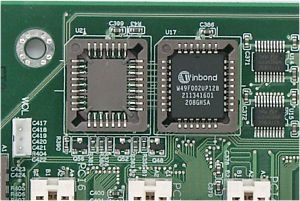Albatron KX400+ (VIA KT333) Mainboard
|
Albatron is a new name on the mainboard market. The company was founded
in 1984 and till recently it was famous for its big multimedia monitors,
projecting equipment and plasma-panel displays under the Monivision trade
mark. But in this year, when the former vice-president of Gigabyte came
here with its team Albatron decided to expand its scope of activity and
start production of mainboards and video adapters.
We received a pre-production sample. Accessories:
- Package: cardboard laminated box;
- Documentation: three pages with a brief description of connectors and switches;
- Cables: 1 ATA66/100/133 and 1 FDD;
- Bracket with two USB ports.

The layout is quite convenient, however, audio-ins and a power connector
are put in between the AGP slot and the rear panel's unit. It's not difficult
to reach jumpers and switches even when the board is already installed.
Their functions are shown on the textolite.
The 2-channel switching voltage regulator incorporates 3 capacitors
of 3300 uF and 6 of 2200 uF.
The following controllers are integrated:
- audio controller based on the Avance Logic ALC650 AC'97 codec with a connector
for front audio-outs and support of acoustic systems 5.1.
The board supports the following proprietary technologies: BIOS Mirror
(contents of BIOS can be recovered in case of damage - this is what the
second Flash EEPROM chip is for) and Voice Genie (sound indication of problems
for the POST procedure).

The system monitoring is supported by the Winbond W83697HF chip. What
is controlled:
- voltage of processor, +3.3, +5 and +12 V, AGP and memory buses, VBAT and
+5 V Standby;
- speed of 2 fans;
- temperatures of the processor (thermodiod in processor socket) and the board (a built-in
sensor).
There are 2 connectors for adjustable connection of fans and 3 for non-adjustable
connection (one is for a cooler on a heatsink of the chipset's north bridge).
Brief characteristics of the board: memory slots - 3 DDR SDRAM;
expansion slots - AGP/ 6 PCI/ CNR; I/O ports - 2 COM/ LPT/ 2 PS/2/ 4 USB
1.1; dimensions - 305x220 mm.
Adjustment can be carried out with:
| jumpers and switches |
Jumper to clear up the CMOS |
 |
| Jumper to choose a FSB frequency |
100, 133 and 166 MHz |
| Switches to change a CPU multiplier |
Default, x5-x12.5 |
| Switches to choose the BIOS Mirror mode |
Normal/Rescue |
| Switches to choose a language of the Voice Genie |
English, Chinese, Japanese, German |
| BIOS based on the ver.6.00PG from Phoenix-Award |
Setup of memory timings |
+ |
CAS Latency, Precharge to Active, Active to Precharge, Active
to CMD, Burst Length, Queue Depth, Command Rate |
| Setup of memory frequency |
+ |
DDR:CPU = 2, 2.66, 3.33 (FSB 100 MHz: DDR200, DDR266, DDR333;
FSB 133 MHz: DDR 266, DDR355, DDR444) |
| Setup of AGP bus |
+ |
 |
| Setup of PCI bus |
+ |
 |
| Changeable scaler of AGP and PCI buses |
- |
 |
| Manual assignment of interrupts |
+ |
 |
| Changeable FSB frequency |
+ |
100-233 MHz in 1 MHz steps |
| Changeable CPU multiplier |
+ |
x5.5-x14 |
| Changeable core voltage |
+ |
1.1-1.85V in 0.025V steps |
| Changeable memory voltage |
+ |
2.5, 2.6, 2.7 and 2.8V |
| Changeable chipset voltage |
- |
 |
| Changeable AGP bus voltage |
- |
 |
We used the latest available version of the BIOS - 1.01.
The board hasn't surprised us because we know the team that developed
it quite well. Of course, it's difficult to overcome a distrustful attitude
toward a new-comer on the market, but in this case the products deserve
more trust than a completely unknown trade mark. Besides, the mainbaords
of this company are not expensive.
Test results:
Write a comment below. No registration needed!
|
|
 |
|
|
|


